|
|
Nerve Cells
The nervous system is the body's information gatherer, storage
center and control system. Its overall functions are to collect
information about the body's external/internal states and transfer
this information to the brain (afferent system), to analyze this
information, and to send impulses out (efferent system) to initiate
appropriate motor responses to meet the body's needs.
The system is composed of
specialized cells, termed nerve cells or neurons, that communicate
with each other and with other cells in the body. A neuron has three
parts:
- the cell body,
containing the nucleus
- dendrites, hair-like
structures surrounding the cell body, which conduct incoming
signals.
- the axon (or
nerve fiber), varying in length from a millimeter to a meter,
which conduct outgoing signals emitted by the neuron. Axons are
encased in a fat-like sheath, called myelin, which acts like an
insulator and, along with the Nodes of Ranvier, speeds impulse
transmission.
Typically a given neuron is connected to many thousands of
neurons. The specific point of contact between the axon of one cell and a
dendrite of another is called a synapse. Messages passed to and
from the brain take the form of electrical impulses, or action
potentials, produced by a chemical change that progresses along the
axon. At the synapse, the impulse causes the release of
neurotransmitters (like acetylcholine or dopamine)
and this, in turn, drives the impulse to the next neuron. These impulses
travel very fast along these chain of neurons -- up to 250 miles per hour.
This contrasts with other systems, such as the endocrine
system, which may take many hours to respond with
hormones.
The nerve cell bodies are generally located in groups. Within the
brain and spinal cord, the collections of neurons are called nuclei
and constitute the gray matter, so-called because of their color.
Outside the brain and spinal cord the groups are called ganglia.
The remaining areas of the nervous system are tracts of axons, the
white matter, so-called because of white myelin sheath. Tracts
carrying information of a specific type, such as pain or vision, generally
have specific names.
Somatosensory
Receptors
Input (afferent system) to the nervous system is in the
form of our five senses: touch/pain, vision, taste, smell, and hearing.
Pain, temperature, and pressure are known as somatic senses.
Sensory receptors are classified according to the type of energy they can
detect and respond to.
- Mechanoreceptors:
hearing and balance, stretching.
- Photoreceptors:
light.
- Chemoreceptors:
smell and taste mainly, as well as internal sensors in the digestive and
circulatory systems.
- Thermoreceptors:
changes in temperature.
- Electroreceptors:
detect electrical currents in the surrounding
environment.
Major Divisions of the Nervous
System
The
nerves of the body are organized into two major systems:
The two systems function together, with
nerves from the periphery entering and becoming part of the central
nervous system, and vice versa.
 |
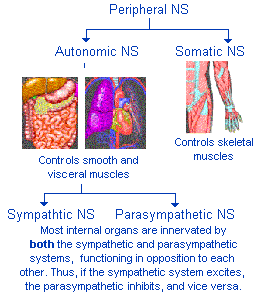
- In the PNS,
collections of neurons are
called
ganglia.
|
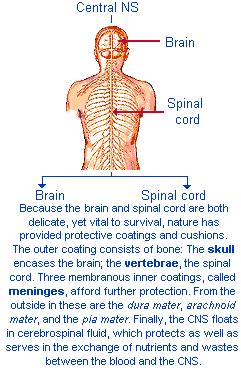
- In the CNS,
collections of neurons
are called
nuclei. |
Brain
Structures
Cerebrum
The largest division of the brain, the
cerebrum, consists of two sides, the right and left cerebral
hemispheres, which are interconnected by the corpus callosum.
The two hemispheres are "twins," each with centers for receiving sensory
(afferent) information and for intiating motor (efferent)
responses. The left side sends and receives information to/from the
right side of the body, and vice versa. Various intellectual
functions are concentrated in either the left or right
hemispheres.
The hemispheres are covered by
a thin layer of gray matter known as the cerebral cortex. The
interior portion consists of white matter, tracts, and nuclei (gray
matter) where synapses occur. Each hemisphere of the cerebral cortex is
divided into four "lobes" by
various sulci and gyri: The sulci (or fissures) are the
grooves and the gyri are the "bumps" on the brain's surface.
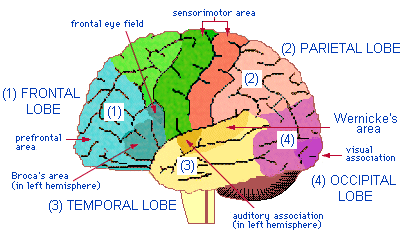 |
 Web
resources: Web
resources:
| | The four lobes perform specific
functions:
- frontal
- controls fine movements (Betz cells)/ upper motor
neuron) and smell. Also, center for abstract thinking, judgment, and
language (left hemisphere)
- parietal
- coordinates afferent infromation dealing with pain, temperature, form,
shape, texture, pressure, and position. Some memory functions are also
found here.
- temporal
- handles dreams, memory, and emotions. Center for auditory
function.
- occipital
- governs vision
In addtion to the four
lobes, you find basal ganglia. The basal ganglia, actually
aggregates of neurons (gray matter), constitute the extrapyramidal
system. The extrapyramidal system governs postural adjustment and
gross voluntary movements, as opposed to fine movements,
controlled by the frontal lobe. The basal ganglia receive afferent
input from the cerebral cortex and thalamus.
Their axons synapse in the brain
stem and the spinal
cord.
Function
summary:
- "Consciousness" - awareness
of one's self and one's environment
- Thought/ reasoning/
memory
- Vision, hearing,
touch
- Speech,
language
- Motor control (fine and
gross)/ coordination
- Emotions ("limbic system"
or the "emotional brain")
Cerebellum
The cerebellum,
the second largest brain structure, sits below the cerebrum. Like the
cerebrum, the cerebellum has an outer cortex of gray matter and two
hemispheres. It receives/relays information via the brain
stem. The cerebellum performs 3 major functions, all of which have to
do with skeletal-muscle control:
Function
summary:
- Balance/ Equilibrium of the
trunk (See also: Vestibular
System)
- Muscle tension, spinal
nerve reflexes, posture and balance of the limbs
- Fine motor control, eye
movement. (Incoming information is transferred from the cerebral cortext
via the pons.
Outgoing information goes back to the cortex via the thalamus.)
Cerebellar disease
(abscess, hemorrhage, tumors, trauma) results in ataxia (muscle
incordination), tremors, and disturbances of gait and equilibrium. This
can also interfere with a person's ability to talk, eat, and perform other
self care tasks. Paralysis does not result from loss of cerebellar
function.
Diencephalon
The diencephalon, located between the
cerebrum and the midbrain,
consists of several important structures, two of which are
the:
- Thalamus: large,
bilateral (right thalamus/left thalamus) egg-shaped mass of gray matter
serving as the main synaptic relay center. Receives/relays sensory
information to/from the cerebral cortex, including pain/pleasure
centers.
- Hypothalamus: a
collection of ganglia located below the thalamus and intimatetly
associated with the pituitary gland. It has a variety of functions:
senses changes in body temperature; controls autonomic
activites and hence regulates the sympathetic and parasympathetic
nervous systems; links to the endocrine
system/controls the pituitary gland;
regulates appetite; functions as part of the arousal or alerting
mechanism; and links the mind (emotions) to the body -- sometimes,
unfortunately, to the degree of producing "psychosomatic
disease."
Function summary:
- Voluntary movement/ motor
integration
- Perception/
Sensory/mind-body integration
- Temperature
- Appetite
Brain Stem
The medulla
oblongata, pons,
and midbrain
(mesencephalon or cerebral peduncles) -- often referred to
collectively as the brain stem -- control the most basic life
functions. Of these three, the medulla is the most important. In fact, so
vital is the medulla to survival that diseases or injuries affecting it
often prove fatal. All functions of the brain stem are associated with cranial
nerves III-XII.
Function
summary:
- Breathing/respiration
(pons, medulla)
- Heart rate/ action
(medulla)
- Blood pressure
(vasoconstriction)/ blood vessel diameter (medulla)
- Reflex centers for
pupillary reflexes and eye movements (midbrain, pons); and for vomiting,
coughing, sneezing, swallowing, and hiccuping (medulla).
Blood supply
An intricate arterial structure
supplies the brain with oxygen-rich blood. At the brain stem, two
vertebral arteries, entering through the first cervical vertebrae,
join to form the basilar artery. The
basilar artery along with two internal carotid
arteries, entering through holes at the base of the skull,
interconnect at the Circle of Willis.
From there, the anterior and middle cerebral
arteries arise; the posterior cerebral
artery arises from the basilar system.
Cranial Nerves
There are 12 pairs of
cranial nerves. Some bring information from the sense organs to the
brain; some control muscles; others are connected to glands or
internal organs.
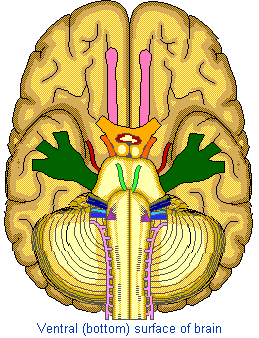 The
nerves are often remembered by the The
nerves are often remembered by the
mnemonic
...
"On Old Olympic Towering Top
A
Famous Vocal German
Viewed Some
Hops"
... standing for:
Ofactory, Optic,
Oculomotor, Trochlear,
Trigeminal, Abducens,
Facial, Vestibulocochlear,
Glossopharyngeal, Vagus,
Spinal accessory, Hypoglossal.
|
| Cranial Nerve |
Major Functions |
| I Olfactory |
smell |
| II Optic |
vision |
| III Oculomotor |
eyelid and
eyeball movement |
| IV Trochlear |
innervates
superior oblique
turns eye downward and
laterally |
| V Trigeminal |
chewing
face & mouth touch
& pain |
| VI Abducens |
turns eye
laterally |
| VII Facial |
controls most
facial expressions
secretion of tears &
saliva
taste |
VIII Vestibulocochlear
(auditory) |
hearing
equillibrium
sensation |
| IX Glossopharyngeal |
taste
senses carotid blood
pressure |
| X Vagus |
senses aortic
blood pressure
slows heart
rate
stimulates digestive organs
taste |
| XI Spinal
Accessory |
controls
trapezius & sternocleidomastoid
controls swallowing
movements |
| XII Hypoglossal |
controls tongue
movements |
|
| | Spinal Cord
 Motions
and Functions Available at Different Levels of Spinal Cord
Injury Motions
and Functions Available at Different Levels of Spinal Cord
Injury
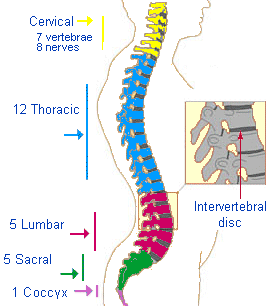 The spinal
cord lies within the spinal cavity, consisting of the vertebral
column, the meninges, spinal nerves, spinal fluid, blood vessels, and
a cushion of adipose/fat tissue. The spinal cord has two general
functions: 1) It provides the two-way conduction routes to/from
(afferent/efferent) the brain; and 2) it serves as the reflex
center for all spinal reflexes. Thirty-one pairs of nerves connect to the
spinal cord. They have no special names, but are numbered according to the
level of the spinal column from which they emerge. There are 8 cervical
(C1-C8), 12 thoracic (T1-T12), 5 lumbar (L1-L5), 5 sacral (S1-S5), and 1
coccygeal pairs of spinal nerves. The spinal
cord lies within the spinal cavity, consisting of the vertebral
column, the meninges, spinal nerves, spinal fluid, blood vessels, and
a cushion of adipose/fat tissue. The spinal cord has two general
functions: 1) It provides the two-way conduction routes to/from
(afferent/efferent) the brain; and 2) it serves as the reflex
center for all spinal reflexes. Thirty-one pairs of nerves connect to the
spinal cord. They have no special names, but are numbered according to the
level of the spinal column from which they emerge. There are 8 cervical
(C1-C8), 12 thoracic (T1-T12), 5 lumbar (L1-L5), 5 sacral (S1-S5), and 1
coccygeal pairs of spinal nerves.
 The figure
below shows a cross-section of the spinal cord at a typical level,
illustrating the position of the horns, where the nerves synapse,
and the three main tracts: The figure
below shows a cross-section of the spinal cord at a typical level,
illustrating the position of the horns, where the nerves synapse,
and the three main tracts:
- Spinothalamic tract,
carrying pain and temperature impulses to the thalamus and the parietal
lobe
- Posterior columns,
carrying position and pressure sense to the thalamus and the parietal
lobe
- Corticospinal (or
pyrimidal) tract, carrying impulses to initiate muscle
activity from the frontal lobe.
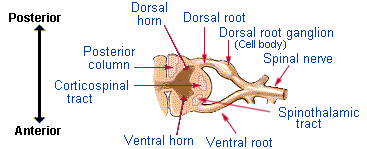 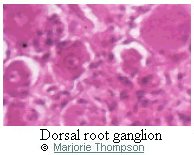
Each nerve has
two roots connecting to the spinal cord: The posterior (dorsal) is the
sensory root; the anterior (ventral) is the motor root. Sensory
receptors send information to the spinal cord (and thus to the brain)
through the spinal nerve. The cell bodies for these nerve fibers are
located in the dorsal
root ganglion and enter the spinal cord through the
dorsal/posterior root. Some fibers synapse with other neurons in
the dorsal/posterior horn, while others continue up to the brain.
The cell bodies in the ventral/anterior horn send axons through the
ventral/anterior root to muscles to control
movement.
Reflexes
A reflex is an automatic,
i.e."involuntary," response of the body to some stimulus, e.g. pupil
dilation, to collect more light, at night. Reflexes have afferent (signals
to the CNS) and efferent (signals from the CNS) components
and may involve one nerve/synapse (monosynaptic reflex) or multiple
synapses (polysynaptic reflex). The simplest spinal reflex is
the tendon reflex, a monosynaptic reflex. When the tendon is tapped, the
sensory receptor in the muscle sends a signal to the spinal cord
(afferent system), where it enters through the dorsal/posterior
root, then synapses with a sensory nerve axon in the ventral/anterior
horn. From there, the receiving axon carries the impulse through the
ventral/anterior root back to the muscle (efferent system) whose
tendon was tapped. The muscle jerks/ contracts.
Spinal/Peripheral Nerves
All cervial spinal nerves
control movement of the shoulder and arm muscles and receive all sensory
input from the skin, muscles, bones, and joints. After leaving the
vertebral canal, they merge to form peripheral nerves. The merger
of the spinal nerves in the neck region is called the brachial
plexis.
Main Action of the Brachial
Plexus Nerves
Modified from: Joel DeLisa and Walter C. Stolov, "Significant
Body Systems," in: Handbook of Severe Disability, edited by
Walter C. Stolov and Michael R. Clowers. US Department of Education,
Rehabilitation Services Administration, 1981, p.
27.
| Peripheral Nerve |
Action |
| Axillary |
Flex and abduct
shoulder |
| Musculocutaneous |
Flex
elbow |
| Radial |
Extend elbow, wrist,
and fingers |
| Median |
Flex wrist and
fingers |
| Ulnar |
Dexterity of
fingers |
The thoracic spinal
nerves do not recombine into plexuses. The anterior roots control the
muscles of the abdomen and back; the posterior roots receive information
from the abdomen, skin, and muscles and joints of the chest and upper
back. The lumbar and sacral nerves, like the cervical, do
combine after leaving the vertebral canal. This merger, occuring in the
pelvis, is called the lumbosacral plexus, which controls the
movement of, and receives information from, the lower extremities,
bladder, and bowel.
Main Action of the Lumbosacral
Plexus Nerves
Modified from: Joel DeLisa and Walter C. Stolov, "Significant
Body Systems," in: Handbook of Severe Disability, edited by
Walter C. Stolov and Michael R. Clowers. US Department of
Education,
Rehabilitation Services Administration, 1981, p.
28.
| Peripheral Nerve |
Action |
| Femoral |
Extend
knee |
| Sciatic |
Flex
knee |
| Tibial |
Flex ankle and
toes |
| Peroneal |
Extend ankle and
toes |
| Pudendal |
Anal and urethral
sphincters and erection |
|
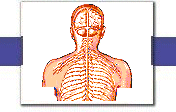
 The spinal
cord lies within the spinal cavity, consisting of the vertebral
column, the meninges, spinal nerves, spinal fluid, blood vessels, and
a cushion of adipose/fat tissue. The spinal cord has two general
functions: 1) It provides the two-way conduction routes to/from
(afferent/efferent) the brain; and 2) it serves as the reflex
center for all spinal reflexes. Thirty-one pairs of nerves connect to the
spinal cord. They have no special names, but are numbered according to the
level of the spinal column from which they emerge. There are 8 cervical
(C1-C8), 12 thoracic (T1-T12), 5 lumbar (L1-L5), 5 sacral (S1-S5), and 1
coccygeal pairs of spinal nerves.
The spinal
cord lies within the spinal cavity, consisting of the vertebral
column, the meninges, spinal nerves, spinal fluid, blood vessels, and
a cushion of adipose/fat tissue. The spinal cord has two general
functions: 1) It provides the two-way conduction routes to/from
(afferent/efferent) the brain; and 2) it serves as the reflex
center for all spinal reflexes. Thirty-one pairs of nerves connect to the
spinal cord. They have no special names, but are numbered according to the
level of the spinal column from which they emerge. There are 8 cervical
(C1-C8), 12 thoracic (T1-T12), 5 lumbar (L1-L5), 5 sacral (S1-S5), and 1
coccygeal pairs of spinal nerves.


